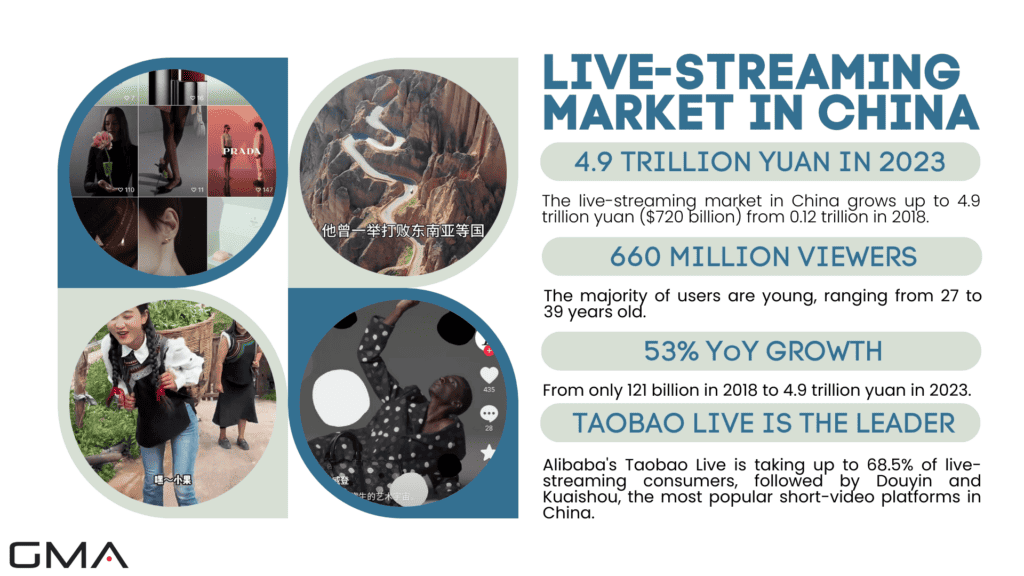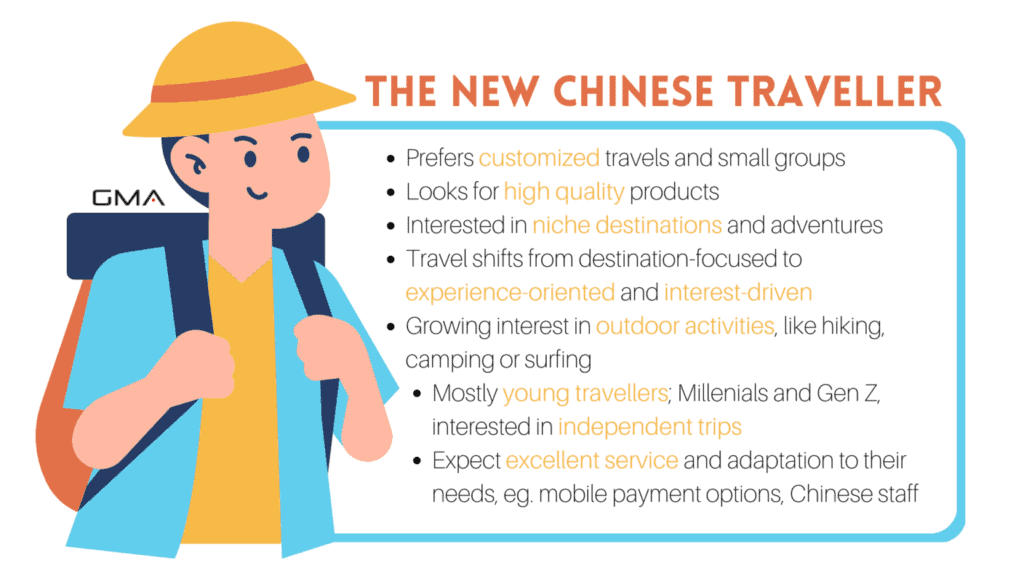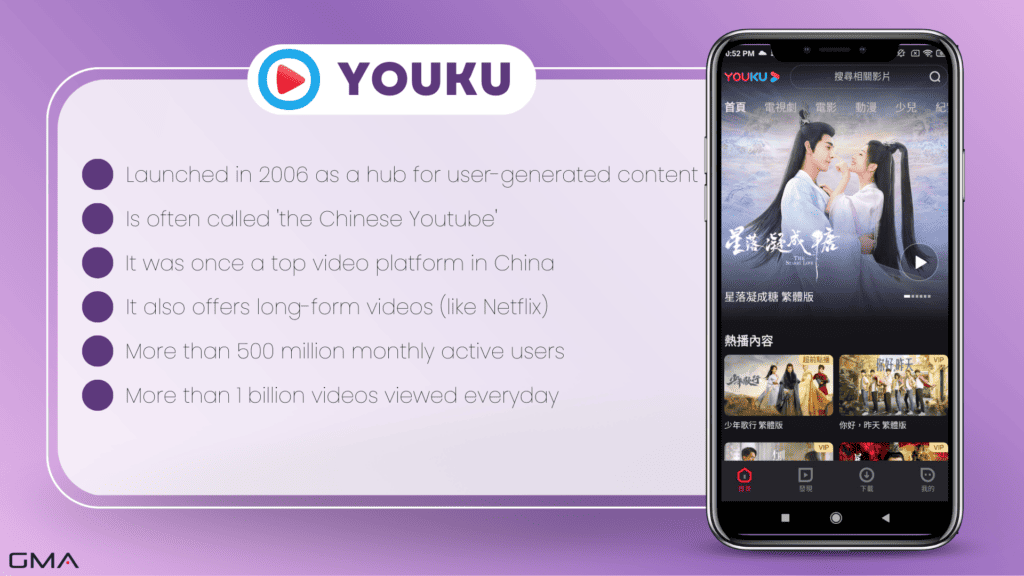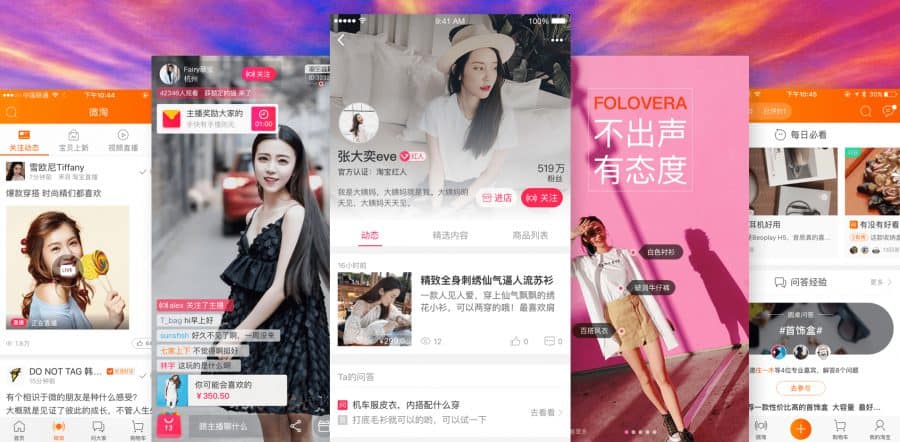How to Use Live Streaming in China to Attract Tourists to a Destination?
China has the world’s largest pool of tourists and in the past decade, Chinese tourism has seen outstanding growth. Now more than ever, Chinese people are traveling and spending more on travel and their destination, as they couldn’t do it for more than 3 years.
But since a few years ago, many things changed and the ways Chinese people look for information or find travel inspiration differ from before. Today, it’s important to adapt your marketing strategy to a new type of Chinese tourist and one of the good tools to do so is live streams.
In this blog post, we will tell you how the live-streaming industry works in China, what are the most popular live-streaming services and how to leverage live-streaming platforms in the tourism industry. Let’s delve in!
What’s Chinese Live-Streaming All About?
The live-streaming industry in China has seen meteoric growth in the last few years, becoming an influential pillar in the country’s digital landscape. As of the last count, China’s live-streaming audience surpassed the 660 million mark, with 53% year-on-year growth, with live-streaming e-commerce generating more than 4.9 trillion RMB ($720 billion) in 2023.
This boom has significantly impacted various industries, with tourism being one of the most notable beneficiaries.

The industry has been growing at a staggering rate, with projections suggesting that by the end of 2023, over 60% of China’s internet users will be engaged in live-streaming activities.
When it comes to the impact on tourism, in 2021, it was reported that about 10% of the total live-streaming audience (around 56 million users) engaged primarily with travel and destination-related content.
Surveys indicate that nearly 45% of Chinese tourists consider live-streaming content as a significant influencer in their travel decisions. They rely on these streams for real-world insights into destinations, hotels, activities, and local culture. Many tourism boards, hotels, and tour operators have integrated direct booking features into their live streams. In 2020, direct sales and bookings from travel-related live streams accounted for an estimated RMB 5.8 billion (around 900 million USD).
The Shift Towards Authentic Travel Experiences
The rise of live-streaming in tourism can be attributed to the Chinese audience’s growing desire for genuine, unfiltered experiences. Unlike polished advertisements, live streams provide a raw, real-time glimpse into destinations, allowing potential tourists to feel, albeit virtually, the essence of a place.
This trend has particularly benefited lesser-known or off-the-beaten-path destinations, which can showcase their unique offerings to millions through influential streamers or their own broadcasts.
Key Benefits of Live Streaming for Tourism Promotion
Live streaming has become an indispensable tool in tourism marketing, and here’s why:
Real-Time Engagement
Live streaming offers an immediate connection between destinations and viewers. This direct interaction, through Q&As or polls, fosters a strong bond and provides instant insights into audience preferences and questions.

Authenticity and Trust-Building
Offering an unfiltered view, live streams present the genuine side of a destination. This raw and authentic portrayal resonates with viewers, building trust and showcasing the true essence of a location.
Showcasing Real-Life Experiences
More than just visuals, live streams convey the emotions and ambiance of a place. From tasting local food to participating in cultural activities, it provides a virtual taste of actual experiences, enticing viewers to consider the destination for their next trip.
Who Are The New Chinese Tourists?

After the COVID-19 pandemic, Chinese tourists have changed their travel habits. They now value health and safety more than ever, choosing places known for cleanliness and good health practices. Many are exploring closer to home, favoring local spots over crowded tourist areas.
Nature trips and relaxing breaks are becoming more popular, as people look for ways to de-stress and connect with nature. Plus, they’re using the internet more to plan trips, find information, and use digital services. For those in the travel business, it’s crucial to recognize these changes and adapt to meet the new needs of Chinese travelers.
The Key Platforms For Video and Live-Streaming
The outbreak of the coronavirus has pushed the tourism industry to pause, but live streaming has brought more possibilities for tourism businesses and platforms.
Youku
In 2012, Youku merged with Tudou to form the giant online video platform Youku Tudou. The platform is one that reported its user base at 500 million unique monthly visitors and successfully bid for ownership of streaming rights for the FIFA World Cup.
Three years before that, it was acquired for $4.8 billion USD by China’s most important and dominant tech and e-commerce company: Alibaba.

Youku Tudou is often referred to as the YouTube of China. One visit to its homepage and it is obvious why. But while YouTube is the mecca of user-generated content, Youku functions analogously closer to Hulu or Netflix. The phrase “online video platform” may be an appropriate catch-all term, but Youku is more precisely an internet television company. It pays for and produces content and earns money through a monthly subscription service.
YiQiyi
Owned by Chinese tech giant Baidu, iQiyi is another important video platform that claims nearly half-a-billion users and over 5.5 billion hours of content streamed each month. Much like how JD and Alibaba compete at the top of China’s e-commerce landscape, iQiyi is in a battle against its top rival, Youku- on top of other popular services offered by Tencent and Sohu.
iQiyi makes its distinct mark in a few high-profile ways. First, it partnered with Netflix in 2016 to stream exclusive Netflix content in China (though that agreement has since expired). Second, it also acquired the popular South Korean show My Love From the Star. That show is such a hit that it has been streamed on iQiyi over 14.5 billion times since December 2013.
Taobao Live
Alibaba, like other major Chinese companies, understands the massive commercial and e-commerce opportunities associated with live-streaming and has made Taobao Live a focal point of its strategy for years.
As a result, the platform is Alibaba’s live-streaming arm that has not only helped with the rise of Key Opinion Leaders (KOLs) and Key Opinion Consumers (KOCs)— many of whom earn millions of dollars by partnering with companies to highlight their products in videos— but it also expects the Taobao Live to generate over 500 billion sales transactions over the next three years.
Taobao Live is by far the most popular platform for live streaming: 79 percent of all e-commerce live-streaming transactions in China occurred on its platform.
Douyin
Though paling in comparison to Taobao Live when it comes to e-commerce live-streaming transactions, Douyin is a platform that any business looking to make inroads in China must be cognizant of. The short-video streaming platform is China’s counterpart to TikTok, of which pop-culture-inclined Westerners are becoming steadily more aware.
While TikTok and Douyin are the same in some fundamental respects, the commercial facet of the latter app is much more developed.
Douyin daily users—numbering in hundreds of millions—can do much more than view short videos. Purchasing a featured product, booking a hotel, and becoming a KOL are all possible through Douyin’s platform. Though, as a percentage of overall e-commerce live-streaming transactions, Douyin is a distant second to Taobao Live, brands would be wise to take note, lest they miss out on perhaps the next biggest thing in Chinese e-commerce.
Kuaishou
Kuaishou tends to target users from lower-tier cities and small towns. This should excite businesses looking to capitalize on this user base, given that lesser-known provinces like Shaanxi, Hubei, Fujian, and Yunnan saw 10 percent growth in consumer goods sales, as opposed to 7.9 percent in Shanghai and just 2.7 percent in Beijing.
Many Chinese e-commerce experts predict that it’s in these regions and cities where consumer growth will continue to be strong.
Strategies to Optimize Live Streaming for Tourist Attraction
Live streaming has become a game-changer for promoting tourist destinations. To ensure you capture the attention and interest of potential travelers, live-streaming hosts should consider these expanded strategies:
Dive Deep into Authentic Local Experiences
Engaging local guides who can narrate personal tales, share legends, and delve into history can make a big difference. It’s also beneficial to display the vitality of traditional events and local festivals, not forgetting the simple charm of everyday life. Featuring regional delicacies and hosting on-the-spot cooking sessions can further enrich the viewer’s experience.
Boost Interaction and Engagement
Boosting interaction is the key to keeping viewers engaged. Regular Q&A sessions where they can inquire about various aspects of the destination, from attractions to accommodations, can be invaluable.
Additionally, offering real-time recommendations and virtual gifts based on viewer feedback and preferences or even holding interactive polls and contests during the live stream can significantly enhance engagement levels.

Leverage Collaborations for Greater Reach
Collaborations also play a pivotal role in expanding your reach. Teaming up with travel bloggers, influencers, or local celebrities can amplify the broadcast’s visibility and lend a touch of credibility to the showcased attractions.
An innovative approach could involve dual streams, where two hosts from different backgrounds, perhaps a local expert and a popular travel influencer, combine their perspectives for a richer narrative.
Offer a Behind-the-Curtain View
Offering viewers a unique behind-the-curtain view can further pique their interest. Exclusive tours of places that are usually off-limits to the public, or showcasing the behind-the-scenes preparations of major events, can provide a fresh, intriguing perspective.
Stay Ahead with Advanced Features
Lastly, to stay ahead in the digital game, it’s crucial to integrate advanced tech features. Incorporating Augmented Reality can overlay fascinating facts onto real-world scenes, while Virtual Reality tours can offer a completely immersive experience. Additionally, providing 360-degree views ensures that viewers capture the full essence of a location, allowing them to virtually explore every nook and cranny.

Effective Promotion of Live Streams
Promoting live streams effectively demands a multi-faceted approach. Here’s a deeper dive into key strategies to ensure your live streams draw significant attention:
Pre-Streaming Hype
Building anticipation is pivotal for the success of any live stream. One effective way to stir up excitement is through the use of compelling teasers and trailers. These short videos can provide a glimpse into the content of the upcoming stream, making viewers eager for the full experience.
Alongside these visual appetizers, regular announcements play a crucial role. By continuously updating your audience about the date, time, and unique highlights of the forthcoming live stream, you keep the event top-of-mind and allow potential viewers to schedule their time accordingly. Pair these announcements with visually appealing graphics, countdowns, or even short interviews with hosts or special guests to further enhance the hype.
Platform Collaboration
Establishing a strong presence on the streaming platform itself is equally vital. A strategic partnership with the platform can lead to premium placements, ensuring your stream captures the attention of those browsing. Being featured on the platform’s homepage or within top-viewed sections can draw in a substantial number of new viewers.
Furthermore, some platforms extend special streaming capabilities to their partners. By tapping into these features, you can provide unique viewing experiences. For instance, integrating interactive elements like polls or Q&A sessions can make the stream more engaging and enhance viewer retention.
We are a Certified Douyin Partner, and can help you get those specific placements!

Social Media and Community Engagement
The vast expanse of social media platforms offers numerous avenues to amplify the reach of your live stream. Regular promotional posts across all your social channels, adorned with popular hashtags and captivating visuals, can capture widespread attention.
Engaging directly with online communities, especially those populated by travel enthusiasts, is another potent strategy. Sharing stream details, addressing queries, and even collaborating with community admins and other live streamers can significantly bolster your promotional efforts.
Furthermore, encouraging user-generated content can create a buzz among tens of thousands of viewers. By prompting followers to share their excitement or expectations and then reposting their content, you not only widen the promotional net but also foster a sense of community and loyalty among viewers.

Case Study: Moganshan District in Deqing County Promotion
To help accelerate the recovery of business and production following the COVID-19 epidemic, before the Labor Day holidays, the Moganshan district in Deqing County provided a series of special offers for family stays through the Livestream to attract tourists who were captured in seconds.
It was a successful attempt by Shen Chanying and his companions, who recently have done live streaming on Taobao Live, the Livestream unit of the Chinese e-commerce giant Alibaba. Their efforts were to show the cozy family houses and local specialties in Moganshan, a city known for its mountain tourist site of the same name. They also expected to introduce Moganshan’s green and slow-paced lifestyle to urban people via live streaming.
The tourism industry, a pillar of Moganshan’s economic structure, has suffered hefty losses as a result of the outbreak, while local agricultural products, such as tea, aquatic products, and fruit, have been hard to sell.
Livestreaming has succeeded in boosting online sales, and also increase the influence of the town. Thanks to these efforts, Moganshan’s tourism industry is recovering steadily.

Choose Gentlemen Marketing Agency for Your Live Streaming Success
If there’s one thing we understand at Gentlemen Marketing Agency, it’s the ever-evolving landscape of Chinese digital marketing, especially in the realm of live streaming. With a vast majority of Chinese consumers tuning into live streams for information, entertainment, and purchase decisions, the medium has emerged as a critical channel for brands, especially in the tourism sector.

Why should you trust us with your live-streaming promotions?
- Expertise in the Chinese Market: Our in-depth understanding of Chinese consumer behavior ensures your live streams resonate with the intended audience. We know what the Chinese traveler is looking for and how to showcase it in real-time.
- Holistic Approach: We don’t just focus on the streaming itself. Our comprehensive promotional strategies include pre-streaming hype, platform collaborations, and effective social media engagement, ensuring your live events get the viewership they deserve.
- Cutting-edge Tools: We stay updated with the latest in technology, from AR to VR, ensuring your content is not just viewed but experienced.
- Network of Influencers: With connections to a broad network of influencers, bloggers, and local celebrities, we can enhance your reach and credibility manifold.
- End-to-End Support: From conceptualization to execution and post-stream analysis, our dedicated team offers support at every step. Our goal is to ensure that each live stream surpasses the last in terms of engagement and conversion.
Let Gentlemen Marketing Agency be your beacon in the bustling world of Chinese live streaming. With our expertise, resources, and dedication, we promise to transform your streams into powerful tools of engagement and conversion.
Reach out today and let’s set the digital stage for your destination’s success!











We are a private Sahara Desert Tour in Morocco, offering Morocco tours and excursions.
We are really interested by livestreaming to catch Chinese tourists